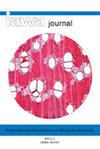干旱胁迫对桉树木材细胞形成和木质化的影响
IF 3.5
3区 农林科学
Q2 FORESTRY
引用次数: 3
摘要
环境适应和细胞分化过程是影响木材解剖成分的因素。本研究的目的是探讨缺水对木质素组成的解剖元件和血管邻近细胞的特性的影响。选用干湿地区6年无性系尾叶桉(Eucalyptus urophylla)和大桉×茶树桉(Eucalyptus grandis × camaldulensis)。所有地区都接受了降雨排除处理。测量血管附近和远处纤维的细胞壁宽度、细胞壁厚度和形状因子。在相同的细胞中,用荧光技术测量了中间薄片和血管中的木质素。血管分化过程影响了邻近细胞的细胞壁厚度和木质素组成。与纤维或血管中心管胞相比,木质素成分在血管中增加。在桉树无性系中,中层木质素不受导管分化和水分亏缺的影响。大叶豆(E. grandis × E. camaldulensis)原产于干燥气候地区,因此在水分胁迫条件下木质素不会发生变化;然而,这个克隆显示出更多的输精管胞。尾叶草原产于湿润气候地区,当缺水时,木质素成分增加,这似乎是更好地利用水资源的策略。不同桉树品种暴露在缺水条件下,其血管、血管心管胞和纤维细胞壁的木质素组成发生变化。本文章由计算机程序翻译,如有差异,请以英文原文为准。
Effect of drought stress on the formation and lignification of eucalyptus wood cells
Environmental adaptation and cell differentiation processes are factors that influence the anatomical elements of wood. The objective of this study was to investigate the effect of water deficit on lignin composition in anatomical elements and on the characteristics of vessel-neighboring cells. Six-year-old clones of Eucalyptus urophylla and Eucalyptus grandis × Eucalyptus camaldulensis from wet and dry regions were used. All regions received a rainfall exclusion treatment. Cell wall width, cell wall thickness, and form factor of fibers close to and far from vessels were measured. In the same cells, lignin was measured in the middle lamella and vessels by a fluorescence technique. The vessel differentiation process affected cell wall thickness and lignin composition in neighboring cells. Lignin composition was increased in vessels compared to fibers or vasicentric tracheids. Middle lamella lignin was not affected by vessel differentiation or water deficit in either eucalyptus clone. E. grandis × E. camaldulensis is originally from a dry climate region and, therefore, did not suffer alterations in lignin when subjected to water stress conditions; however, this clone exhibited a higher number of vasicentric tracheids. E. urophylla is originally from a humid climate region and, when subjected to water deficit, showed increased wood lignin composition, which seems to be a strategy for better use of water resources. Alterations in lignin composition of vessel, vasicentric tracheid, and fiber cell walls resulting from exposure to water deficit conditions vary according to eucalyptus species.
求助全文
通过发布文献求助,成功后即可免费获取论文全文。
去求助
来源期刊

IAWA Journal
农林科学-林学
CiteScore
3.40
自引率
15.80%
发文量
26
审稿时长
>36 weeks
期刊介绍:
The IAWA Journal is the only international periodical fully devoted to structure, function, identification and utilisation of wood and bark in trees, shrubs, lianas, palms, bamboo and herbs. Many papers are of a multidisciplinary nature, linking
 求助内容:
求助内容: 应助结果提醒方式:
应助结果提醒方式:


